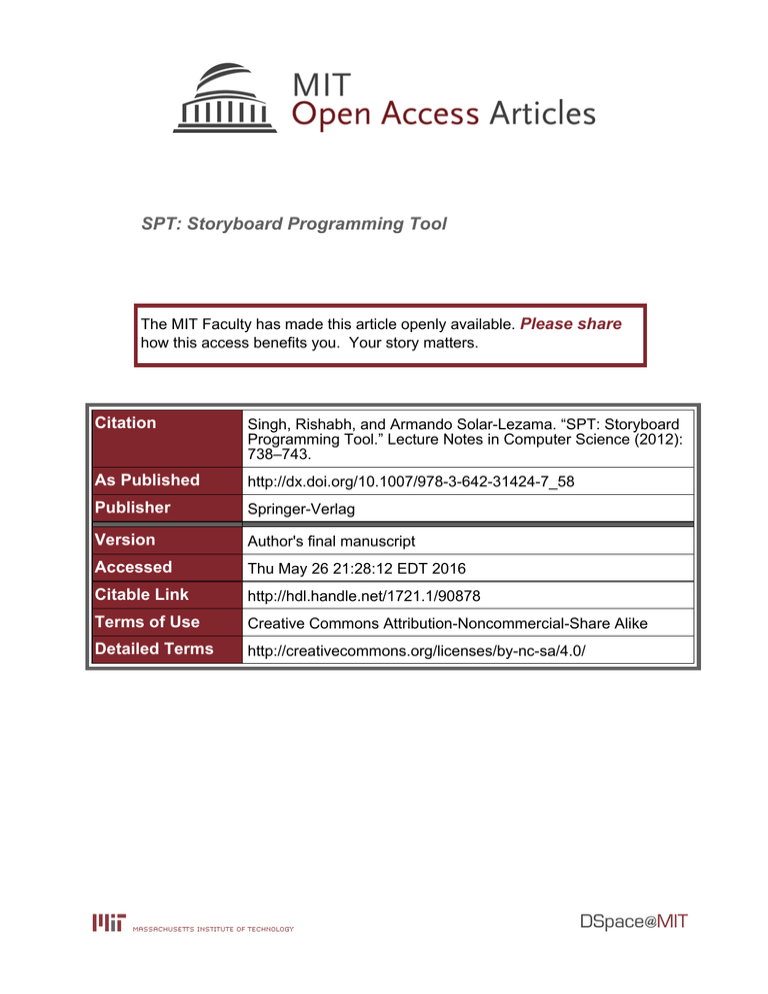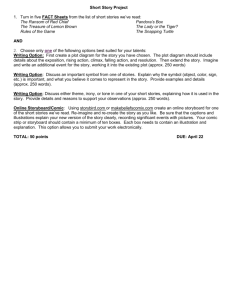SPT: Storyboard Programming Tool Please share
advertisement

SPT: Storyboard Programming Tool
The MIT Faculty has made this article openly available. Please share
how this access benefits you. Your story matters.
Citation
Singh, Rishabh, and Armando Solar-Lezama. “SPT: Storyboard
Programming Tool.” Lecture Notes in Computer Science (2012):
738–743.
As Published
http://dx.doi.org/10.1007/978-3-642-31424-7_58
Publisher
Springer-Verlag
Version
Author's final manuscript
Accessed
Thu May 26 21:28:12 EDT 2016
Citable Link
http://hdl.handle.net/1721.1/90878
Terms of Use
Creative Commons Attribution-Noncommercial-Share Alike
Detailed Terms
http://creativecommons.org/licenses/by-nc-sa/4.0/
SPT: Storyboard Programming Tool
Rishabh Singh? and Armando Solar-Lezama
MIT CSAIL, Cambridge, MA, USA
Abstract. We present Spt, a tool that helps programmers write lowlevel data-structure manipulations by combining various forms of insights
such as abstract and concrete input-output examples as well as implementation skeletons. When programmers write such manipulations, they
typically have a clear high-level intuition about how the manipulation
should work, but implementing efficient low-level pointer manipulating
code is error-prone. Our tool aims to bridge the gap between the intuition
and the corresponding implementation by automatically synthesizing the
implementation. The tool frames the synthesis problem as a generalization of an abstract-interpretation based shape analysis, and represents
the problem as a set of constraints which are solved efficiently by the
Sketch solver. We report the successful evaluation of our tool on synthesizing several linked list and binary search tree manipulations.
1
Introduction
When programmers write data-structure manipulations, they typically have clear
high-level visual insights about how the manipulation should work, but the translation of these insights to efficient low-level pointer manipulating code is difficult and error prone. Program synthesis [1, 5, 6] offers an opportunity to improve
productivity by automating this translation. This paper describes our tool Spt1
(Storyboard Programming Tool) that helps programmers write low-level implementations of data-structure manipulations by combining various forms of
insights, including abstract and concrete input-output examples as well as implementation skeletons.
Our tool is based on a new synthesis algorithm [4] that combines abstractinterpretation based shape-analysis [2, 3] with constraint-based synthesis [5, 7,
8]. The algorithm uses an abstraction refinement based approach to concisely
encode synthesis constraints obtained from shape analysis.
In this paper, we present a high-level storyboard language that allows programmers to succinctly express the different elements that make up a storyboard.
The language is more concise than the one described in [4] thanks to the use
of inference to derive many low-level details of the storyboard. The paper also
describes the architecture of the Storyboard Programming Tool and presents
some new results comparing Spt with the Sketch synthesis system.
?
1
Supported by NSF under grant CCF-1116362.
The Storyboard tool and benchmarks are available
http:/people.csail.mit.edu/rishabh/storyboard-website/
for
download
at
2
Overview: Linked List deletion
We present an overview of our tool using linked list deletion as a running example. The goal of this manipulation is to delete a node pointed to by a variable y
from an acyclic singly linked list. The manipulation iterates over the list until it
finds the required node and then performs a sequence of pointer assignments to
delete the node. Spt synthesizes an imperative implementation of deletion from
a high-level storyboard in about two minutes.
The storyboard that Spt takes as input is composed of scenarios, inductive
definitions and a loop skeleton. A scenario describes the (potentially abstract)
state of a data-structure at different stages of the manipulation. Each scenario
contains at least two configurations: input and output corresponding to the state
of the data-structure before and after the manipulation; a scenario may also
contain descriptions of the state at intermediate points in the computation.
The scenarios for linked list deletion are shown in Figure 1(a), and the corresponding visual description of the scenarios is shown in Figure 1(b). The first
scenario s1 describes an abstract input-output example, where the input list
consists of two summary nodes front and back and a concrete node ly that is to
be deleted. In this case, the summary node serves as an abstract representation
of a list of arbitrary size. In general, a summary node represents an arbitrary set
of nodes; those nodes in the set which are connected to other nodes not in the
set are given concrete names and are called attachment points. The summary
node front contains two attachment points front::f and front::l denoting the
first and last elements of the front list respectively.
The state configurations are defined using a list of state predicates such as
(head -> front::f) which denotes that the head variable points to the attachment point f of front. The other scenarios s2, s3 and s4 correspond to the cases
of deleting the last node, the first node and the only node of the list respectively.
Notice that there is no scenario corresponding to the case where the node to be
deleted is not in the list. That means that the behavior of the synthesized code
will be unspecified in such a case.
In order for the synthesizer to reason about summary nodes, the user needs to
specify their structure. In this case, for example, the user needs to express the fact
that front and back are not just arbitrary sets of nodes; they are lists. In Spt,
this structural information is provided inductively through unfold rules. The
two possible unfold rules for the summary node front and their corresponding
visual description are shown in Figure 2. The rule states that the summary node
front either represents a single node x or a node x followed by another similar
summary node front. The unfold predicate consists of the summary node, the
replacement node, the incoming and outgoing edges, and additional constraints
that hold after the unfold operation. In Spt, the programmer can also provide
fold rules to describe to the system how sets of nodes can be summarized by
a single node. In most cases, such as the example, the synthesizer can reason
about the correctness of a manipulation by using the inverse of the unfold rules
for summarization, but for some tree algorithms, the synthesis process can be
made more efficient by providing explicit fold rules for summarization.
scenario s1
y
head
input: head -> front::f, y -> ly
back
front
next
next
ly
f
l
f
l
front::l.next -> ly,
back::l -> null, ly.next -> back::f
output: head -> front::f,
s1
front::l.next -> back::f,
head
back::l.next -> null
back
front
next
next
f
l
f
l
scenario s2
input: head -> front::f, y -> ly
ly.next -> null, front::l.next -> ly
output: head -> front::f,
head y
front::l.next -> null
back
scenario s3
next
next
ly
f
l
input: head -> ly,ly.next -> back::f,
y -> ly, back::l.next -> null
s3
output: head -> back::f,
back::l.next -> null
head
scenario s4
back
next
f
l
input: head -> ly,ly.next -> null,y -> ly
output: head -> null
(a)
y
head
next
front
f
l
s2
f
front
head
l
y
ly
next
s4
head
Fig. 1. Scenarios describing input and output state descriptions for linked list deletion.
x
front
l
next
next
next
x
front
f
front
f
front
f
l
next
l
l
next
x
next
next
x
ly
head
(b)
f
next
next
unfold front::f x [in (front::f, x)] [out (front::l, x)] ()
unfold front::f x [in (front::f, x)] [out (front::l, front::l)] (x.next -> front::f)
unfold front::f x [in (front::f, x)] [out (front::l, x)] ()
unfold front::f x [in (front::f, front::f)] [out (front::l, x)] (front::l.next -> x)
Fig. 2. Two possible unfold definitions for summary node front.
In addition to the scenario descriptions, Spt also requires users to provide
a loop skeleton of the desired implementation. This helps the synthesizer focus
on implementations that are close to the user’s expectations, and also lets them
specify intermediate state constraints. The loop skeleton for the running example is shown in Figure 3(a). It consists of a while loop with a set of unknown
statements before the loop, in the loop body and after the loop. The unknown
statements are denoted by the ??(n) operator, where n represents the maximum
length of the unknown statement block. Spt restricts unknown statements to
be of two forms: i) guarded statements of the form if(**) then ASSIGN, where
** represents a conditional over pointer variables and ASSIGN denotes pointer assignments with at most one pointer dereference, and ii) unfold/fold statements
of the form unfold var (resp. fold var) that corresponds to unfolding (folding)
the location pointed to by variable var.
next
next
llDelete(Node head, Node y){
Node temp, prev;
??(2) /* h1 */
while(**){ /* h2 */
??(4) /* h3 */
}
??(2) /* h4 */
}
llDelete(Node head, Node y){
Node temp, prev;
temp = head;
while(temp != y){
// unfold temp1;
prev = temp;
temp = temp.next;
// fold prev;
}
if(prev == null)
head = temp.next;
if(prev != null)
prev.next = temp.next;
}
llinsert(Node head, Node y)
{
Node temp1, temp2;
??(2) /* h1 */
while(**){ /* h2 */
??(4) /* h3 */
}
/* position of y found */
yPosFound:
??(4) /* h4 */
}
(a)
(b)
(c)
Fig. 3. (a) The loop skeleton and (b) the synthesized implementation for linked list
deletion and (c) the loop skeleton for sorted linked list insertion.
Given the scenarios, recursive definitions and the loop skeleton, Spt synthesizes the imperative implementation shown in Figure 3(b). The true conditionals
and skip statements are removed from the code for better readability.
3
Algorithm
The details of the synthesis algorithm used by Spt can be found in [4]. At a
high level, the algorithm first translates the loop skeleton into a set of equations
relating the inputs and outputs of all the unknown blocks of code. Let Fi denote
the unknown transfer function that maps a set of program states to another set
of program states. The relationships between the inputs and outputs of all the
transfer functions is captured by a set of equations of the form:
[
(t0 = Ink ) ∧ ∀vi ∈(V \v0 ) ti = Fi (
tj )
(1)
j∈pred(vi )
where pred(vi ) denotes the predecessors of node vi in the cfg. Ink denotes the
input state constraint for the k th scenario, and the goal is to find Fi such that
tN = Outk for each scenario k. The system works by representing the Fi as parameterized functions and solving for the parameters by using a counterexample
guided inductive synthesis [4].
4
Tool Architecture
The architecture of Storyboard Programming Tool consists of four major components as shown in Figure 4:
A. Storyboard Parser: The parser takes as input a storyboard description
(*.sb) written in the storyboard language and translates it into our intermediate constraint language that consists of a set of prolog predicates (*.pl). The
STORYBOARD PROGRAMMING TOOL
C implementation
.c
.sb
input storyboard
A
STORYBOARD
PARSER
D
CODE
GENERATOR
.pl
CONSTRAINT
GENERATOR
B
.out
.sk
C
SKETCH
SOLVER
Fig. 4. The architecture of Storyboard Programming Tool.
storyboard language is more concise than [4] because the parser also performs
some type inference to infer variables, locations, selectors, and summary nodes.
B. Constraint Generator: The constraint generator translates the prolog
predicates into a sketch constraint file (*.sk). Sketch provides an expressive
language to define the shape analysis problem, allowing us to use high-level language constructs such as functions, arrays and structures to model the abstract
state, as well as holes to model the unknown transfer functions. The problem is
encoded in a way that leverages the counterexample guided inductive synthesis
algorithm of sketch to avoid having to represent sets of shapes explicitly.
C. Sketch Solver: The Sketch solver solves the sketch constraint file and
produces an output (.out) file where all unknown function choices are resolved.
D. Code Generator: The code generator takes as input the output generated
by the Sketch solver and completes the loop skeleton (.c) by mapping the function choice values to their corresponding program statements and conditionals
using the intermediate constraint file (*.pl).
5
Experiments and Tool Experiences
We evaluated the tool on several linked list and binary search tree manipulations as well as AIG (And-Inverter Graph) insertion. The details about the
experiments and benchmarks can be found in [4]. We present here a comparison
with the Sketch tool on a small sample of benchmarks.
Comparison with Sketch: Table 1 shows the running times of the Storyboard tool with the Sketch system. We can see that Sketch is faster, but can
only perform bounded reasoning (N=5) and quickly times out for larger values
of N. On the other hand, the storyboard tool performs unbounded analysis using abstract interpretation. However, the biggest difference we found was in the
usability of the tools. We had to spend almost three hours for writing a spec in
Sketch for these manipulations. For writing a sketch, one has to write a converter (and its inverse) for converting (resp. translating back) an array to that
Benchmark Sketch Storyboard
(N=5)
ll-reverse
18s
1m40s
ll-insert
31s
2m3s
ll-delete
25s
2m8s
bst-search
39s
2m51s
bst-insert 3m35s
3m12s
Table 1. Performance comparison with Sketch.
data structure. Then one has to use quantified input variables for writing tricky
specs. In our storyboard tool, we only have to provide input-output examples
which in our experience was a lot more natural. We now present some of our
other experiences in handling complicated manipulations with the tool.
Intermediate State Configurations: Our tool allows users to write intermediate state configurations to reduce the search space and enable the synthesizer
to synthesize more complex manipulations. The user can label a program location in the loop skeleton and provide the state description at that point using
the intermediate keyword as part of the scenario description. For example in the
case of insertion in a sorted linked list, we add an additional insight based on
the fact that the loop skeleton for the insertion (Figure 3(c)) is performing two
tasks: first to find a suitable location for inserting the node y and the second task
of inserting y into the list. In the abstract scenario, we provide an intermediate
state configuration at the label yPosFound in which two variables point to the
two locations between which the insertion is to be performed.
The Spt tool illustrates a new approach to synthesis namely Multimodal
Synthesis, where the synthesizer takes input specification in many different forms
such as concrete examples, abstract examples, and implementation insights, and
synthesizes code that is provably consistent with all of them. We believe this
idea of multimodal synthesis has applicability in many other domains as well.
References
1. B. Jobstmann, A. Griesmayer, and R. Bloem. Program repair as a game. In CAV,
pages 226–238, 2005.
2. T. Lev-Ami and S. Sagiv. TVLA: A system for implementing static analyses. In
SAS, pages 280–301, 2000.
3. M. Sagiv, T. Reps, and R. Wilhelm. Parametric shape analysis via 3-valued logic.
In POPL, pages 105–118, 1999.
4. R. Singh and A. Solar-Lezama. Synthesizing data structure manipulations from
storyboards. In FSE, pages 289–299, 2011.
5. A. Solar-Lezama. Program Synthesis By Sketching. PhD thesis, EECS, UC Berkeley,
2008.
6. A. Solar-Lezama, R. Rabbah, R. Bodik, and K. Ebcioglu. Programming by sketching
for bit-streaming programs. In PLDI, pages 281–294, 2005.
7. S. Srivastava, S. Gulwani, and J. S. Foster. From program verification to program
synthesis. In POPL, pages 313–326, 2010.
8. M. T. Vechev, E. Yahav, and G. Yorsh. Abstraction-guided synthesis of synchronization. In POPL, pages 327–338, 2010.




